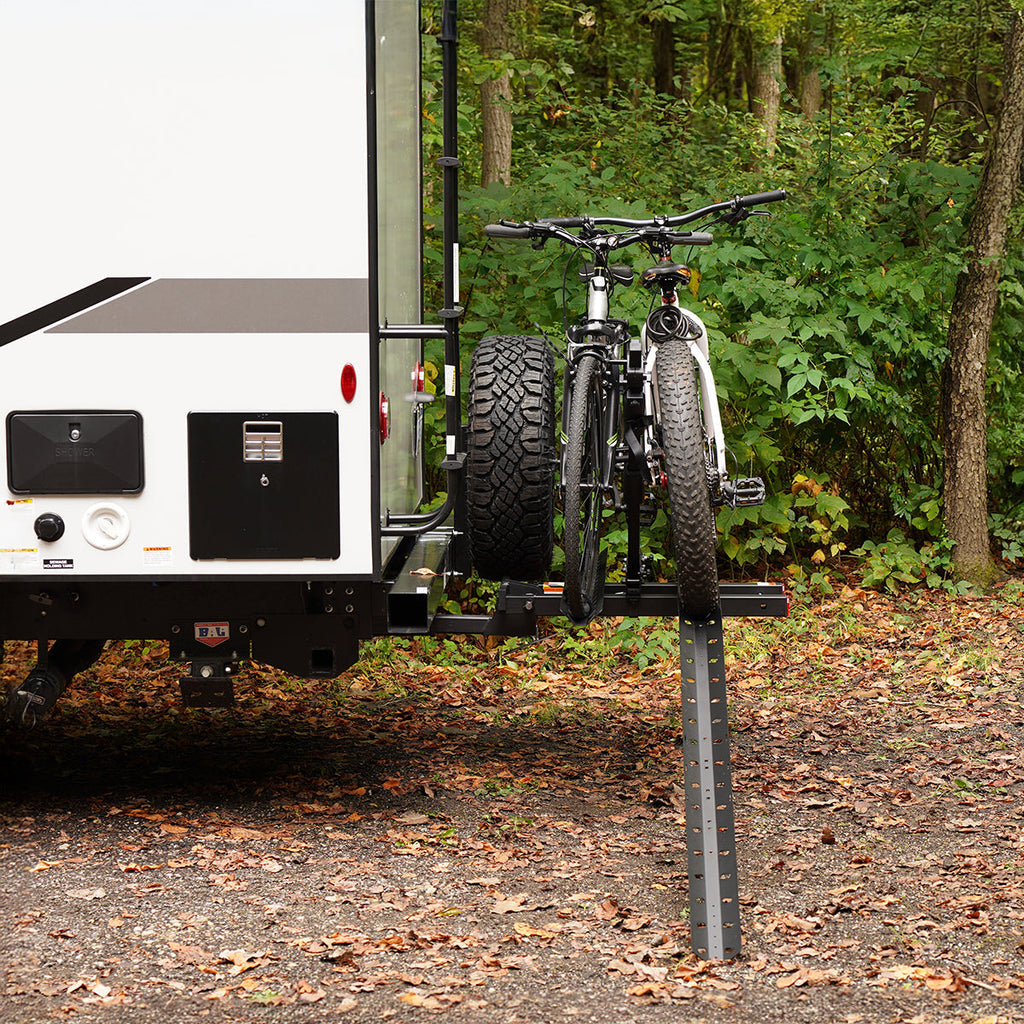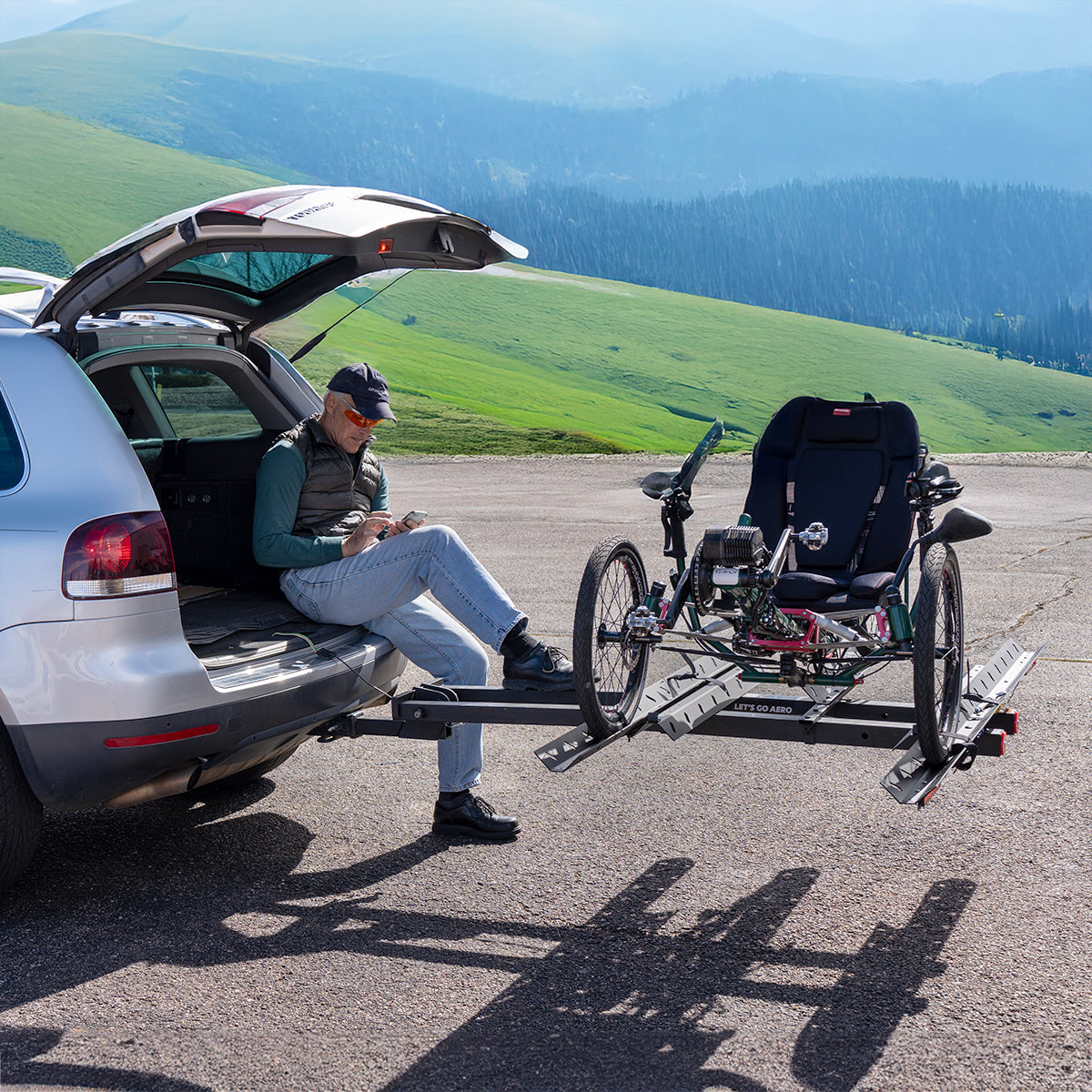
Bringing bikes along on your RV adventures is one of the best ways to expand what you can do at camp. Whether it’s cruising through the campground, exploring mountain trails, or heading into town for supplies, having your bikes with you is a game-changer. But not all bike racks are built to handle the unique stress of a RV trip. So, what makes a bike rack RV approved, and why does it matter? Let’s break it down.

What Does “RV Approved” Mean for Bike Racks?
“RV approved” means that the bike rack has been tested and rated by its manufacturer for use on RVs, travel trailers, and towables. Unlike a rack mounted on a car, the back of a trailer is a much harsher environment. The long overhang, stiff suspension, and rougher ride put far more strain on a rack than the rear of a passenger vehicle ever would.
Because of this, many regular hitch-mounted bike racks don’t qualify. They might have lighter weight capacities, thinner materials, or moving parts that simply won’t withstand the constant bouncing and sway of RV travel. Some manufacturers even void the warranty if their rack is used on an RV.
If you’re shopping, look for racks that are specifically labeled for RV or travel trailer use. These racks are reinforced with heavier steel and built to handle the unique stresses of trailer towing. For a deeper dive, check out our guide on Bike Racks for Travel Trailers.

How Legit Are RV-Rated Bike Racks?
It’s fair to ask: is “RV approved” just a marketing label, or is it the real deal? The good news is that reputable bike rack manufacturers put their carriers through extra testing to simulate the harsher ride. This includes vibration, bounce, and sway tolerance checks that go beyond what’s required for racks used on cars or SUVs.
Legit RV-approved bike racks are often simpler and sturdier in design. They may limit capacity to two bikes, use thick welded steel, avoid weak points and have enhanced stability features. Many also feature anti-sway hardware, reinforced hitch mounts and anti-rattle hitch pins. The end result is a rack that stays put even after thousands of miles of highway and backroad towing.
If you’re looking for examples of RV rated bike carriers, Let’s Go Aero’s TwinTube® platform racks and Jack-IT® A-frame racks are both purpose-built for trailers. You can browse these options and more in our RV Travel Trailer Rated Bike Racks collection.

What’s the Difference Between Class 1 and Class 2 Bike Racks?
This often comes down to your hitch and its class.
- Class I Hitch Receivers use a smaller 1¼-inch receiver, often found on cars and light SUVs. They typically max out at about 200 lbs tongue weight, which limits them to lighter racks and just one or two bikes. Despite some travel trailers having Class 1 tow hitches, bike racks made for 1.25in hitches are typically not rated for travel trailers.
- Class II Hitch Receivers also use a 1¼-inch and 2-inch receivers but are rated stronger, usually up to 350 lbs tongue weight. These can handle heavier racks and more bike options.
- Class III Hitch Receivers (the most common on RVs and trailers) exclusively use a 2-inch receiver and are rated for much higher weights, making them the safest match for an RV bike rack.
Class matters because the bouncing forces on an RV can make a 40 lb bike feel like double that. Using a rack on too small a hitch is asking for trouble. To understand more about hitch classes and load ratings, check out our guide on Motorhome Towing Capacity.

Can You Use a Regular Bike Rack on an RV or Trailer?
Technically you can because it will fit, but you shouldn't. Regular bike racks aren’t built for the rough ride at the back of a trailer. Using one could lead to cracked welds, broken bolts, or even lost bikes on the highway. And if the rack fails, you’re out of luck—most manufacturers won’t honor the warranty if their rack was used on an RV without approval.
It’s also important to mount your RV Approved bike rack in the right place:
- Rear bumper mounts are unsafe. Those thin bumper mounted hitch receivers aren’t built for heavy loads. We never recommend using bolt-on bumpers for any hitch accessory.
- Hitch-mounted receivers are safe as long as your hitch has a high enough weight rating. See above section for explanation on weight ratings.
- A-frame or tongue-mounted receivers are one of the most stable options. These vertical racks sit over the trailer’s axle and experience less bounce.
Some RVers also consider using a cargo carrier or a bike/cargo rack combination instead of a rack. Our article on Bicycle Cargo Carrier vs. Bike Rack compares the two options.

What Features Should I Look for in an RV Bike Rack?
When shopping for an RV-rated rack, prioritize strength and stability over convenience features. Here are the most important things to look for:
- Heavy-duty steel construction with a travel trailer approved rating
- Simple design with fewer moving parts
- Anti-sway, anti-rattle or other hitch stabilizers
- High per-bike load capacity (especially for e-bikes or mountain bikes)
- Secure clamping or wheel-hold systems
- Compatibility with your bike types (fat tires, step-through frames, or long wheelbases)
If you plan on carrying e-bikes or fat bikes, double-check the rack’s capacity and features. Some models, like Let’s Go Aero’s V-Lectric e-bike racks, are built specifically with heavy e-bikes in mind. For more guidance, see our article on E-Bike Transportation.

Do I Need a Bike Cover for My RV Bike Rack?
Covers aren’t required, but they’re often a smart accessory. On long drives, your bikes will face wind, rain, and road debris. A good cover helps protect paint, drivetrains, and electronics from damage.
That said, choose wisely. A flimsy cover can act like a parachute and add stress to your rack. Look for travel-ready bike covers that secure tightly and won’t flap in the wind. Some even feature clear panels or integrated lights so your RV’s taillights remain visible.

Final Tips for Choosing the Right RV Bike Rack
Finding the right rack is all about matching it to your RV, your bikes, and your travel style. Here’s a quick checklist to guide your decision:

With the right RV bike rack, you’ll have peace of mind knowing your bikes are safe and secure, no matter how rough the road gets. That means more time enjoying the ride, less stress about equipment failure, and the confidence to explore further on two wheels.
Choosing an RV-approved rack is an investment in both safety and adventure. It protects your bikes, safeguards your RV, and ensures that every mile you travel leads to more fun, not more repairs. Whether you’re carrying lightweight road bikes, rugged mountain bikes, or heavy-duty e-bikes, the right rack keeps them ready for action the moment you roll into camp.
If you’re ready to upgrade your setup, explore our full lineup of Let’s Go Aero Travel Trailer Rated Bike Racks, engineered and tested for the demands of RV life.



